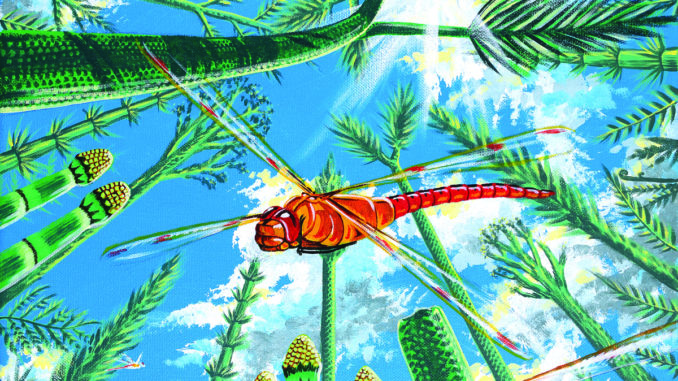
By R. Gary Raham, Nature writer/illustrator
Modern cars may skim down the highway with sleek exteriors and aerodynamic contours, but auto enthusiasts still appreciate “classics” like the rugged model T that was able to survive rutted trails more suited to horses. Likewise, entomologists—not to mention your average nature enthusiast—love to observe the rainbow colors of butterflies and the seemingly infinite variety of beetles, while still marveling at the classic insect remnants of Paleozoic times called dragonflies. You can find them easily on local foothills trails or even invite them to your own yard with a bit of planning to accommodate their needs.
Dragonflies resemble biwing planes with two pair of large, transparent wings extended, even when at rest. Their huge eyes may remind you of the goggles old aviators used flying in open cockpits. Dragonflies have many common names including mosquito hawks, devil’s darning needles (or devil’s horses), and snake doctors. While European common names tend to associate dragonflies with evil, they are considered omens of good luck in Japan and much of Asia, and commonly appeared as art motifs in Native American southwest art. Dragonflies are not only harmless to humans, but they consume lots of potentially disease-carrying mosquitoes and are a wonder to observe as they dart and dive in search of prey or a mate. With little economic importance, however, they remain understudied and sometimes misunderstood.
If their flying needle form looks intimidating to “bugaphobes,” consider what it would be like to meet their Permian relatives that lived some 300 million years ago. Meganeuropsis permiana found in the Kansas Elmo Formation, stretched 28 inches from wingtip to wingtip. Some of our own small mammalian ancestors would have done well to stay out of their way.
Dragonflies are professional predators as both larvae and adults. Adults possess “wrap-around” eyes with some 280 degrees of acute vision. Their spiny legs hang down like grappling hooks and surround their prey in a basket-like cage. Independently movable wings give them a maneuverability that’s the envy of helicopter pilots.
But their larvae (nymphs) are the really awesome killers. They hatch from eggs deposited by females in ponds, lakes, streams, or any body of available water. (In fact, females will sometimes dive bomb the shiny hoods of cars, mistaking them for puddles.) Larvae look like six-legged tanks armed with hook-like teeth that spring forward on a hinged extension of their mouth parts and impale mosquito larvae, tadpoles, small fish, and whatever else blunders by. Once hooked, the prey gets hauled back to the dragonfly nymph’s real chewing apparatus, the mandibles, where they are cut to munchable-sized shreds.
Dragonflies spend 98% of their lives as nymphs. The colorful adults we admire are merely sexual phase show-offs, but watching them is fun. Males stake out territories near ponds or other bodies of water. A male uses the tip of his abdomen to transfer a sperm packet from his 9th abdominal segment to his second so the claspers on his 10th segment will be free to grab a passing female by the neck. Once so commandeered, the female loops her abdomen around to snag the sperm packet with her sexual organs. You may see these dragonfly ring gymnastics either while the insects are perched on a plant stem or in flight. The male may stay attached until the female lays her eggs or just hang around to make sure another male can’t claim paternity.
People can attract dragonflies to their yards by creative garden planning that includes elements of standing and/or flowing water—water being essential to dragonfly reproduction. Even a 150-gallon water garden will attract a variety of dragonflies and damselflies. Females will lay eggs that hatch into nymphs, which you can also observe or raise in small containers to directly see which nymphs produce which dragonfly adults. Adults like to perch on nearby plants and some nymphs require soil at the bottom of the water container in which to burrow.
For a fun visual reference to common dragonflies in Colorado, check out https://www.inaturalist.org/check_lists/57919-Dragonflies-and-Damselflies-of-Colorado
Naturalists don’t need fantasy video games while the local dragons of summer are flying outside. These insects provide hours of pleasurable observation and a solid appreciation of “classic” insect design.
Support Northern Colorado Journalism
Show your support for North Forty News by helping us produce more content. It's a kind and simple gesture that will help us continue to bring more content to you.
BONUS - Donors get a link in their receipt to sign up for our once-per-week instant text messaging alert. Get your e-copy of North Forty News the moment it is released!
Click to Donate
